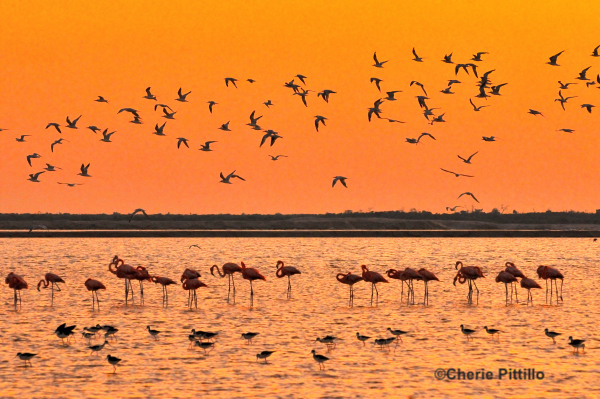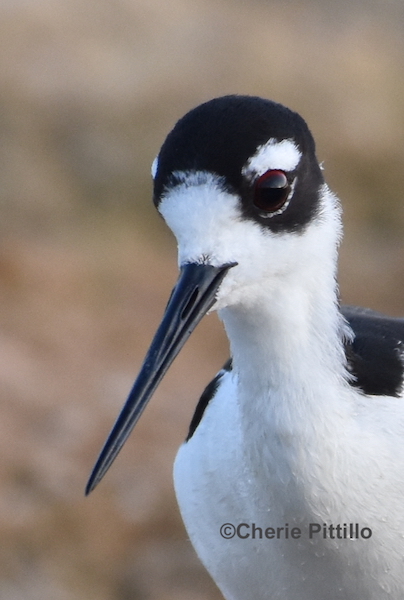Black-necked Stilt, Himantopus mexicanus, Monjita Americana (Spanish), Ook che’e (Mayan)

Sporting a black and white tuxedo with thigh high pink boots (in a bird that’s knee high), the male Black-necked Stilt stuns as a thin legged, thin billed, thin shorebird. In fact many sources state this species has the longest legs of any bird in the world in proportion to its body. However, it doesn’t have a leg to stand on since the flamingo holds that record. But it is the second honoree.



From a distance a flock of Black-necked Stilts appears black, but on closer inspection the female wears some brownish plumage and an immature dons a brownish back. This color difference in adult sexes is unlike most other shorebirds. Also the 15” tall male has longer legs than the adult female.


The stilt selects shallow salt or freshwater to feed in or on the surface or plunge its head underwater. It may visually see its prey, chase it, catch it in the air, stab it, or swing its bill from side to side to feel it, a tactile approach. Aquatic invertebrates, like insects and crustaceans, form its main prey, but the stilt can be opportunistic to dine on tadpoles, tiny fish, snails, butterflies, moths, and spiders. Some references state seeds and vegetation can be a small part of the diet too.


It lives in many different wetlands such as mangroves, mudflats, salt marshes, flooded fields, sewage ponds but it always
breeds at fresh water. When a pair nest on the ground, one stands guard while the other scrapes away about two inches of dirt with its breast and feet. Sometimes grass, leaves, shells, bones, or rocks may line the nest or nothing may be used.
Other times an algae floating mat, vegetative clumps in water, or small islands can be used for nesting. If the water level should rise, the birds add more nest material to keep it above the waterline. They may nest in loose colonies with their own species and other shorebirds including their cousins, the American Avocets, or atypically with gulls, terns, and grebes. A breeding pair may nest in isolation too.

I actually photographed a pair nesting in a shallow, watery catchment basin behind a Walmart. At the far end of this 400’ long basin, the pair had built a nest, but I couldn’t recognize it as such. What I did understand was the noisy pair flew across the “lake” to land about 50’ from me. She pretended to be nesting at one site (false brooding), then fly to another and sit as if incubating, and so on, and so on. Meanwhile the male flew around calling loudly. I didn’t see him perform the false brood. I think the female said, “He’s not heavy, he’s my brooder.” Yes, both parents incubate the 3-5 eggs.
SOUND link: https://www.xeno-canto.org/species/Himantopus-mexicanus?pg=2



Other than this display to distract a predator to lead it away from the nest, another common tactic is the broken wing display which the female used. I left so as not to disturb them more. Remember, I’m 400 feet from the nest, so this stilt species is highly territorial against members of its breeding colonies, other shorebirds, other predators, and humans.




Once the 3-5 young hatch, they can swim in about two hours and are able to swim underwater to avoid predation.
Black-necked Stilts range in wetlands from North America south to central Argentina and also the Caribbean. They are residents in the Yucatan with a transient migratory winter population.
Depending on the resource, this stilt is divided into three subspecies in the Americas on how much black and white exists on its body. A southern form may be called the White-backed Stilt, and an endangered form in Hawaii is a great Scrabble word, Aeo or Ae’o! No need to buy a vowel! But other scientists link this stilt to the Black-winged Stilt of Eurasia and Africa.
Maybe that’s why the stilt seems to complain so much with its rackety calls!

YOU DON’T HAVE TO DRESS FANCY LIKE THE STILT TO ENJOY NATURE!
DISCLAIMER: References REALLY do not agree on data about this species.
Sal a Pajarear Yucatán, Bird & Reserves of the Yucatan Peninsula, A Guide to the Birds of Mexico and North Central America, A Guide to the Birds of Costa Rica, Florida’s Birds, Sibley Guide to Bird Life and Behavior, Lives of North American Birds, Field Guide to Birds of North America
https://www.hbw.com/species/black-winged-stilt-himantopus-himantopus
https://neotropical.birds.cornell.edu/Species-Account/nb/species/bknsti/overview
https://www.allaboutbirds.org/guide/Black-necked_Stilt/lifehistory
https://birdsna.org/Species-Account/bna/species/bknsti/introduction
https://seaworld.org/animals/facts/birds/black-necked-stilt/
Cherie Pittillo, “nature inspired,” photographer and author, explores nature everywhere she goes. She’s identified 56 bird species in her Merida, Yucatan backyard view. Her monthly column features anecdotes about birding in Merida, Yucatan and also wildlife beyond the Yucatan.
Contact: [email protected] All rights reserved, ©Cherie Pittillo

